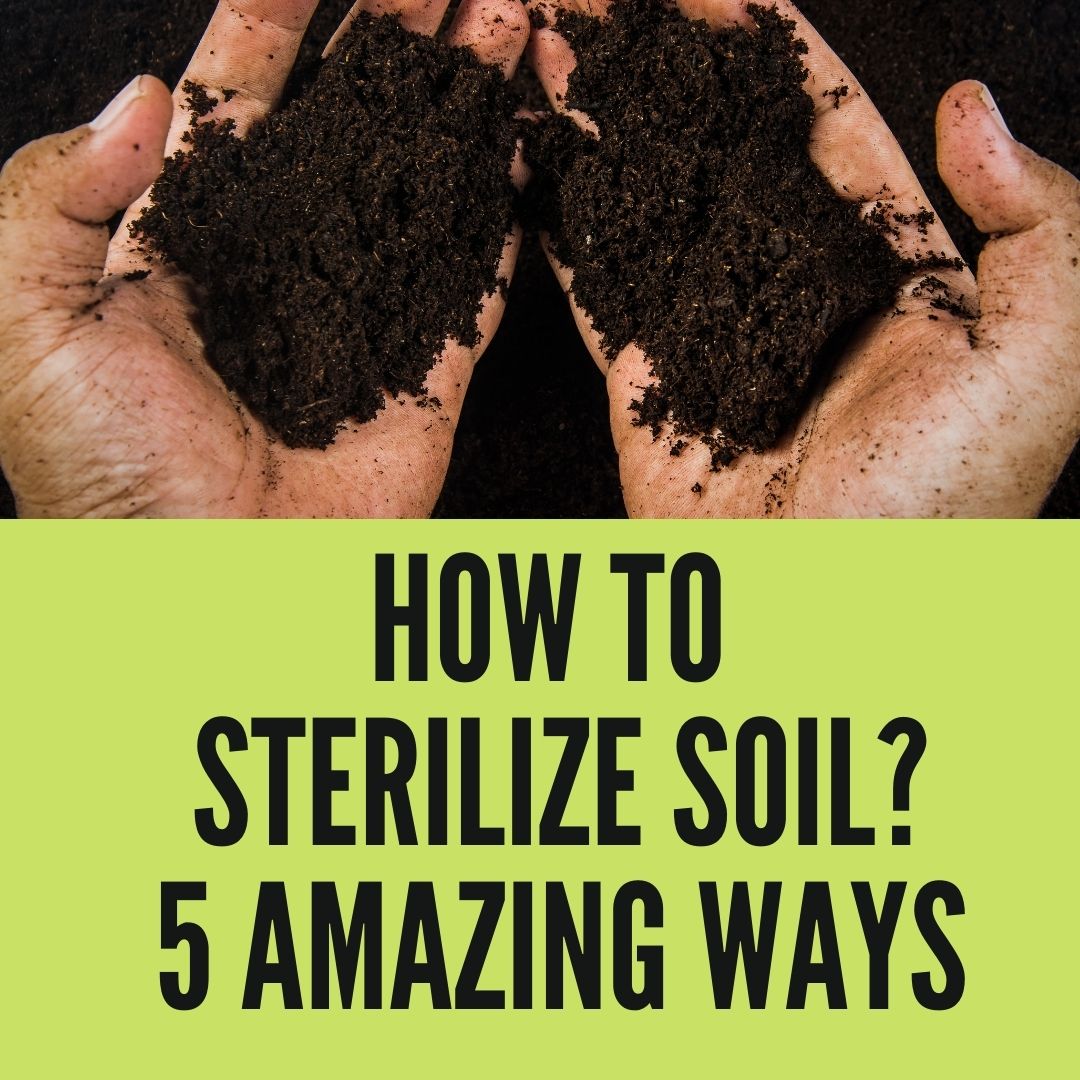If you are a gardener, then you know the importance of soil.
If not, let me quickly explain.
Soil is made up of minerals and organic material that help plants grow healthy roots. The process for sterilizing soil varies depending on what type of soil it is.
For example, if your soil is garden topsoil or potting mix that’s been bagged at the store and contains no other types of dirt or compost in it, then it can be overwatered to get rid of any bacteria left over from manufacturing the product.
But If your soil is a mixture of different types like peat moss mixed with clay-based loam, then adding boiling water will kill off most microbes without harming the plant nutrients in them.

What is Soil Sterilization?
Sterilizing soil is a process that will kill any living or nonliving organisms in the soil. It’s often used by gardeners who are looking to start their own plants from scratch, as it ensures no harm can come to them.
To create an ideal condition for your plant’s growth as well as the development of the soil, you’ll need to Sterilize Soil. The sterilization of micro-organisms helps to release particular nutrients to the plant.
But how to sterilize soil?
You will find both chemical and physical (sunlight, oven, microwave) soil sterilization methods.
Now, we will discuss the importance and methods of soil sterilization and suggest what will be the best sterilization method for you.
Why is it Necessary to Sterilize Soil?

You should sterilize soil to eradicate harmful micro-organisms such as pathogens, fungi, bacteria, weeds, pests, etc.
The micro-organism affects negatively the growth of the plant. If the soil is infected by a fungal spore, mold, or other harmful organisms, the rate of damping-off and other plant problems increases.
Moreover, a wide variety of vegetables, flowers, and mature plants can be affected through micro-organisms. To protect the plants, you must sterilize your soil.
However, if you want to reuse the soil rather than buy new bags of soil that may still contain pathogens, weeds, and maybe even seeds from last plants, so, you need to consider sterilization from time to time rather than risk your plant’s health.
Let us discuss the methods of soil sterilization.
There are 5 Ways to Sterilize Soil –
- Sterilize Soil with Chemicals
- Sterilize Soil with the Sun
- Sterilize Soil with Steam
- Sterilize Soil with an Oven
- Sterilize Soil with a Microwave
1) Sterilize Soil with Chemicals
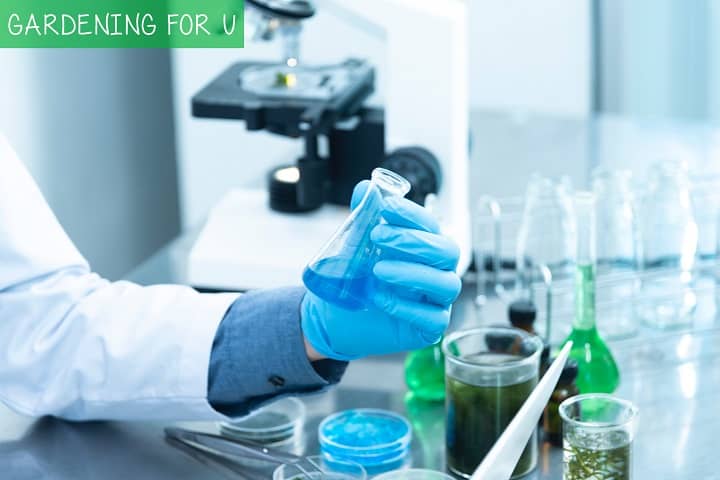
Chemical sterilization is used in a large number of commercial spheres. It is prevalent for economical reasons. Though chemical sterilization can be useful for amateur gardeners, extensive care must be taken to follow the procedure correctly.
Chemical sterilization is an effortless method to use, and the application can be done quickly. Even the mineral soil or potting mix soil is extensive in amount; you can apply the chemical sterilization method correctly.
Generally, the chemical gives off the gas which is adequately toxic enough to eradicate the pathogen, pests, and weeds without harming the beneficial organisms in the soil.
The efficiency of chemical sterilization varies greatly. You may find some difficulties for which chemical sterilization is not widespread to the amateur gardener.
Moreover, the chemical application can create a health risk to the plant and the person who applied, and those in close proximity.
After the chemical application, a quarantine time should be maintained before using the soil. It is essential to allow the chemical to degrade the substrate completely.
If the application is not done correctly, the residue may linger a long time and damage the plant. Using chemical sterilization treatment for a long time may not be ideal; it will demolish the fertility of the soil.
2) Sterilize Soil with the Sun
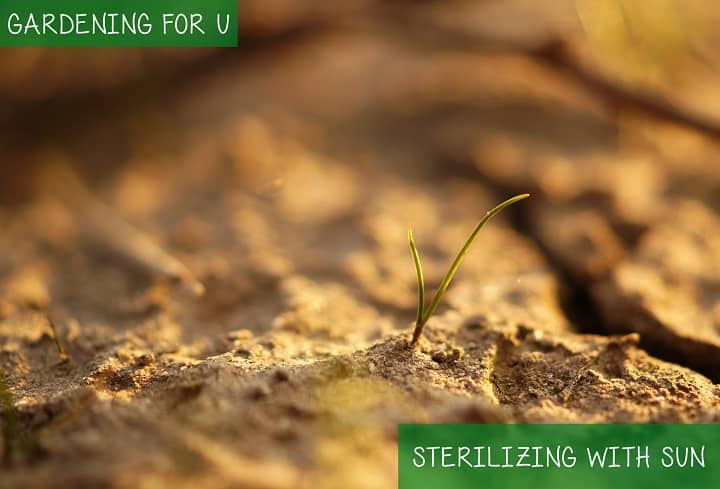
Using a natural source of energy, the sun is a common way to sterilize a massive quantity of soil. Especially you can sterilize the entire garden or fields without spending much.
The sterilization of the sun is taken place by covering the soil with plastic and left it to absorb the rays from the sun, over some time the increasing temperature kills the bacteria, pathogens, and micro-organisms.
The sun sterilization can be done in three different ways, but the result will be the same.
- The entire garden or field is covered with plastic to hold the sun energy.
- A large amount of soil is spread between the bottom and top layer of the plastic to hold solar energy.
- A small amount of potting mix or mineral soil is placed in the plastic bag and put in the sun.
It is your preference which one you want to choose. The thickness of plastic varies differently. Transparent plastic is a better selection than black plastic for sun sterilization. Moreover, thinner plastic can absorb the heat more quickly but a high chance to tear off easily by the animal. Medium thickness (2 mm) works better for any condition.
Among the above three, you can like one method for sun sterilization, but there are some preparations before sterilization. Firstly, start by breaking up all the clods and removing the debris from the previous plant.
Next, spread out the soil evenly in the bottom layer of the plastic, make sure it is not more than a few inches deep. Before covering the top layer of the plastic, irrigate the soil uniformly until they are slightly moistened.
Secure the edge of plastic with rocks or layers of soil. If you want to use a plastic bag, fill the bag with soil, and close tightly, put it in a sunny place.
In sunny weather, sun sterilization takes four to six weeks, and it takes eight to ten weeks in the windy and cloudy climate.
3) Sterilize Soil with Steam
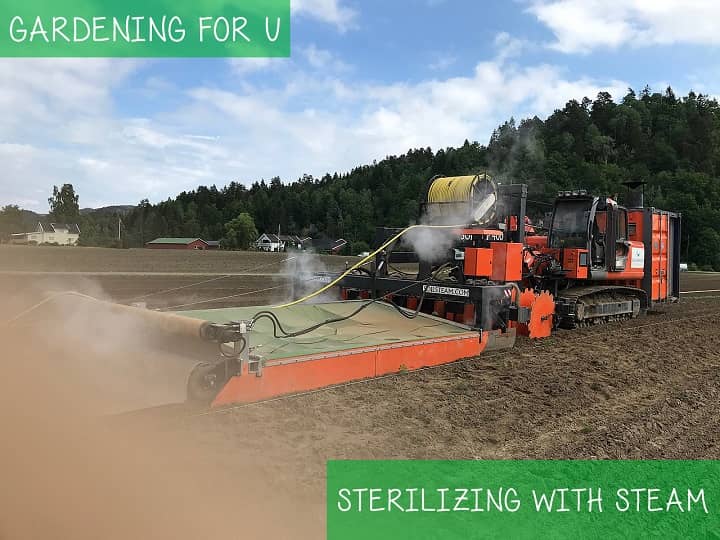
Soil can be efficiently sterilized with the help of steam. The sterilization can be done with or without a pressure cooker. In this method, the soil needs to steam for 30min, or until it reaches 180degree Fahrenheit.
If you want to use a pressure cooker, pour the pressure cooker with a couple-cup of water and insert a rack into the cooker, place a heatproof container with not more than 4-inches of soil.
Cover each container tightly with aluminum foil. Place the lid on the cooker and leave the steam valve open to allow the steam to vent. Adjust the heat source and leave the soil to sterilize at 10lbs for 15 to 30 minutes.
Finally, remove the heat source and keep the sterilized soil covered until it is the right time to use it.
4) Sterilize Soil with an Oven
It is one of the best methods to remove bacteria and many other microorganisms. Moreover, you can proceed with the method indoor. You have to maintain the following procedure step by step:
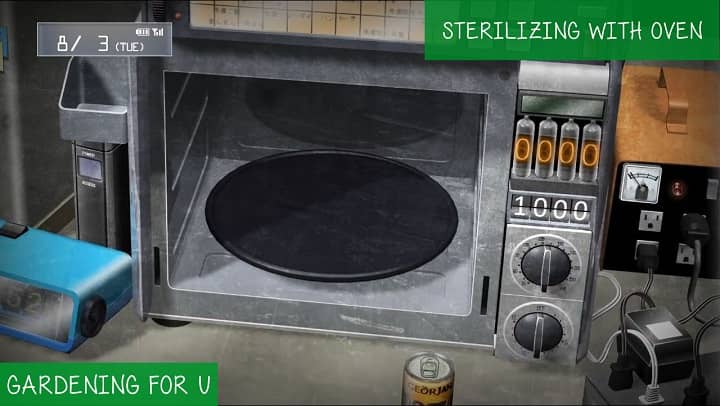
- Firstly, you should add 3-inches of soil to an oven-proof pot or container.
- Secondly, mix in an exact amount of water to moisten the soil, but not so much that it becomes overly saturated. Remember one thing, too much water may slow down the process extensively.
- Thirdly, you have to cover the tops of the containers with aluminium foil carefully. Then directly place the containers in an oven which has already preheated to 200℉.
- Fourthly, observe the internal temperature of the soil with a thermometer. When the temperature goes to 180℉, allow it to “bake” for twenty-five to thirty minutes. Don’t open the oven door within this short time.
- Finally, after thirty minutes, shut the oven off and allow the soil to cool to room temperature.
But, after sterilizing soil with an oven, an unpleasant odor will be created in your house. So, proceed with the method into a room where you will find enough ventilation and try to open your doors and windows.
5) Sterilize Soil with a Microwave
If you want to sterilize a small amount of soil, you can use the microwave method. This procedure is different from the oven method. In the previous oven method, you have covered the tops of the containers with aluminum foil. But this time, cover with plastic wrap. Remember one thing; the soil should not contain any metal.
Procedure
- Firstly, place a small amount (about two pounds) of moist soil inside a clean zip-top plastic bag. Remember, the soil should not be waterlogged but damp enough it holds together in a clump.
- Secondly, you have to leave the top of the bag open and place it precisely in the center of the microwave carefully.
- Thirdly, microwave on high until the soil reaches a temperature between 182℉ and 198℉. Moreover, the length of time this takes to achieve will depend on the capability of your microwave.
- Finally, remove the bag from the microwave. Then carefully close the top of the bag, and place inside a cooler until the temperature comes back down to the ambient conditions. Stay patience to get better performance.
Which is the best method for soil sterilization?
Sterilizing soil with steam is considered one of the best methods to sterilize. It is an easy and quick sterilization process. You can easily sterilize potting mix soil through steaming in a short time (at least 30 minutes or until it reaches 180-degree Fahrenheit).
The steaming method is advantageous to eradicate all micro-organisms, spores, and viruses. You can use this method to sterilize the soil.
FAQ About Soil Sterilization
1. How Do You Sterilize Soil?
These are –
1. Sterilize Soil with Chemicals
2. Sterilize Soil with the Sun
3. Sterilize Soil with Steam
4. Sterilize Soil with an Oven
5. Sterilize Soil with a Microwave
Depending on the condition and quantity of the soil, you may use any of these 5 methods to sterilize the soil.
2. Does Sterilizing Soil Remove Nutrients?
If you sterilize soil, it’ll also kill or removes beneficial microbes for your plants from the soil. So in a sense, you can say that sterilizing soil removes nutrients from the soil.
3. How Can I Sanitize My Soil Without Baking It?
You can use the sunlight as it’s cost-effective and risk-free. You can use chemicals for a quick sterilization process as well if you’re growing at a commercial level.
Using steam and heating the soil with 180 degrees Fahrenheit can achieve soil sterilization. You can also pull off the sterilization using boiling water. Put the soil in a bowl, pour boiling water on it and stir it using a spoon or a utensil. It’ll kill most or all of the things you want to be removed.
Conclusion
You can eradicate weed seeds, pathogens, and harmful micro-organisms from mineral soil and potting mixes by the process of soil sterilization. You can use both chemical or heat treatments to sterilize the soil.
Moreover, soil sterilization provides a healthy plantation environment. When the bacteria and organisms die due to the sterilization process, then you will find particular nutrients get released to the plant such as nitrate which increases plant growth as well.
And, soil sterilization drives to premium quality in commercial production. Additionally, it reduces the growth of micro-organism that is harmful to crop plant. By sterilizing soil, you can control the disease outbreak in the soil.
However, it provides a clean, growing environment for the plantation that encourages strong, healthy growth of plants. Furthermore, if you are at home, you can use a variety of heat treatments (oven method, microwave method) cheaply and efficiently to sterilize the soil.
Here, we have briefly discussed how to sterilize the soil. So, you can follow these methods to sterilize soil entirely.
I Hope, you will be able to increase the growth of plants and also develop soil quality by sterilizing the soil. Now, happy gardening!
Do you want to know how to do low maintenance gardening? Read this post on Low maintenance gardening.
Source: researchgate
